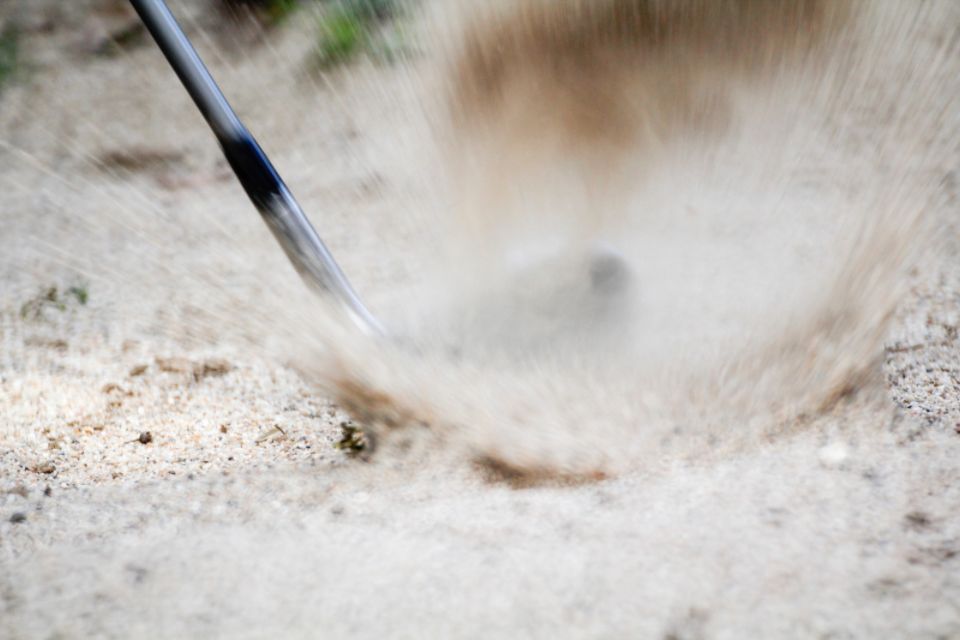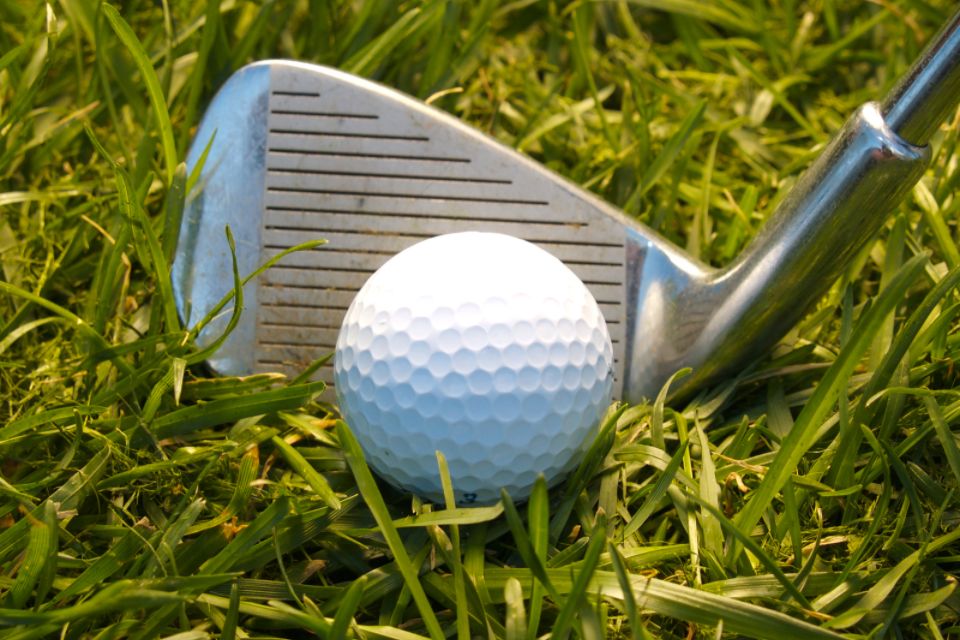Understanding Clubs: The 4 Types Of Golf Wedges

It’s fair to say that the golf wedge is the unsung hero of your set. While drivers and putters often steal the headlines, the wedge is there to pick up the pieces and carry you along the way.
However, it’s unfair to categorize the wedge purely as a firefighter. In fact, there are four types of golf wedge (the pitching, sand, lob, and gap wedge), each with its own nuance and value.
But what exactly are they, what can they bring to your game, and how should you select yours?
To answer these questions and more, the big hitters at Golf Circuit have produced the following comprehensive guide to the 4 types of golf wedges.
What Are the 4 Types of Golf Wedges?
Pitching wedge (46-48 degrees)

The pitching wedge has the lowest degrees of ‘loft’ of all four golf wedges, meaning its clubface is positioned at a more acute angle than the other three.
What is a pitching wedge used for?
The sheer clubface provided by a pitching wedge means it recommends itself for shots taken within 120 yards of the green and that require a lower trajectory.
Sand wedge (54-58 degrees)

Next up is the sand wedge. With a loft of 54-58 degrees, the sand wedge combines a substantially more open face with the widest sole (underside of the clubhead).
What is a sand wedge used for?
The sand wedge delivers distance and height simultaneously.
Additionally, while its more open clubface, a sand wedge is primarily used on softer terrain, the sand wedge is also useful for shots within 70-90 yards and when striking the ball downhill.
Lob wedge (59-65 degrees)

Lob wedges have the greatest degree of loft of all four types of wedges.
What is a lob wedge used for?
A specialist chipping club, most golfers reserve lob wedges for shots taken around the green. When used correctly, lob wedges can produce great, looping height over a short distance (30-70 yards).
So, if you’re taking shots around the green and need a little height, lob wedges are the perfect weapon.
Gap wedge (51-53 degrees)

Gap wedges have a significantly lower amount of loft than lob and sand wedges, bridging the loft gap between them and the pitching wedge.
What is a gap wedge used for?
Gap wedges come into their own between 80 and 110 yards from the green. They can deliver a shot that travels further than that delivered by sand wedges, yet with greater loft than your pitching wedge.
A Brief History of the 4 Different Types of Wedges
Pitching wedge
Relatively speaking, pitching wedges are a new tool in golf that can trace their origins back to a sole utility wedge known as a niblick.
In the 1930s, golfers came to recognize a need for a club with more loft than that provided by the humble niblick.
Hence, the niblick was reassigned and redesigned as a ‘9 iron’, and the pitching wedge was born as its natural, numerical successor.
Consequently, to this day, pitching wedges often follow the loft progression of the iron sequence and so can reasonably be regarded as a ’10 iron’.
Sand wedge
At a similar time in golfing history (the 1930s), a golfer called Edwin MacClain identified a hole in his game (pun intended).
Specifically, he realized he needed a new type of wedge that would refine his ability at 70-90 yards and for bunker shots.
Thus, sand wedges were born, and for over half a century, the golfing world operated with just two types of wedges in a set of golf clubs (a terrifying thought, I’m sure you’ll agree).
Lob wedge
Thank goodness, then, for the 1980s.
As hip hop and electronic music came to the fore, so did the development of lob wedges; this time, it was ex-NASA physicist and short-game expert Dave Pelz‘s turn to develop an answer to the increasingly challenging greens kept in the modern game.
Hence, lob wedges were born and would deliver more loft than the pitching and sand wedges before them.
Gap wedge
Unlike their older siblings, gap wedges weren’t created to combat an inherent golfing difficulty.
Instead, their need developed organically between the 1930s and 1990s, as makers of golf clubs increased the loft of their clubs in order to make them more marketable.
This greater loft opened a ‘gap’ between that of the pitching wedge and sand wedge, and, hence, the gap wedge was quite literally developed to ‘fill’ the gap.
The Key Features of Golf Wedges
Loft
Loft denotes the angle of the face of golf clubs relative to the vertical line represented by the shaft.
Therein, the greater the degree of loft, the more open the clubface, and thus, the greater the height that you’ll strike the golf ball.
Likewise, the greater the loft and more open the face, the shorter the distance the ball will travel.
The leading edge and sole
The leading edge of your club is the area where the clubface adjoins the underside, or ‘sole,’ of the head which is just below the ferrule on the golf club.
This is worth noting because, in order to strike the golf ball cleanly, you mustn’t connect with the said edge.
The goal, then, is to practice hitting with a downward motion, as this will help ensure that the edge connects with the ground uniformly and enables the sole to brush across the ground instead of cutting into it.
Bounce
Bounce describes the angle created between the leading edge and the ground when the sole of the club is placed flush upon it.
While bounce may seem like an inconsequential element of your golfing game, its effect on the clarity of your swing is demonstrated by the variety of bounce wedges available.
What to Look for When Choosing Golf Wedges
Sole grind
Sole grinding, also known as the heel grind, is a process that the majority of golf club manufacturers use to tailor their clubs for specific needs and scenarios.
Needless to say, the grinding of the sole of a club can alter the bounce and thus enable you to open up the face of the club with greater dexterity.
That being said, sole grinding is an irreversible practice, and so you should ensure that you know precisely the bounce and camber (curvature of the sole) that you hope to achieve before committing to it.
We’d recommend a greater bounce and camber for golfers who have a steeper, more vertical swing, while those with a shallower, more regular golf swing will benefit from golf wedges with a narrow sole and a lesser bounce size.
Flex
Flex describes the amount that your golf club’s shaft will bend during your swing. In terms of wedges, many have a slightly more flexible portion of the shaft nearer to the clubhead, allowing for delicate flicks, greater trajectory, and more control over elements such as backspin.
The 6 flex strengths
Ladies flex
The ladies flex is the most flexible of all of the shafts available, designed for those who boast a drive under 200 yards.
Senior flex
The senior flex is designed for those who drive between 180-200 yards. Typically, this matches the trajectory of older golfers (hence, ‘Senior’).
Regular flex
The regular flex is best for those of us with a medium to high handicap. Think a drive of 200-250 yards.
Wedge flex
The wedge flex boasts a moderately stiff shaft for players of a medium to low handicap.
Stiff flex
If you have a medium to low handicap and typically drive between 250-300 yards, the stiff flex should offer a satisfying rigidity while still offering a modicum of flexibility.
Extra stiff flex
Finally, the extra stiff flex is clearly the stiffest club shaft on the market and is perfect for those of us who have an accomplished driving technique.
The construction of the shaft
The construction of the shaft is just as important to your game as the flexibility. With that in mind, when choosing our set of golf clubs, we golfers have to decide between two different materials: graphite and steel.
Graphite shafts
Graphite offers a strong yet lighter and more flexible alternative to its heavier steel counterpart. As a result, if, like me, you’re a golfer who has a slower swing, graphite’s lighter weight and increased flex will make your club easier to handle and aid greater distance.
Steel shafts
Steel shafts are heavier and stiffer than graphite. As such, if you’re a more proficient golfer who boasts a faster swing (good for you!), steel should be, and probably already is, your preferred driving material.
This is because it accommodates greater feel, control, and that higher swing velocity.
Distance gapping
As you pull all of the different factors together in order to assemble your wedge set for the course, you want to make sure that you have a club that accommodates your game at any distance. That is to say, you don’t want to leave a gap in your set for any distance.
This is less of a problem for those with a lower handicap as they’ll be able to cope with (and avoid) greater distance gaps. However, less experienced golfers may want to ensure that their wedges cover a broader level of distance.
So, remember, the higher the degrees of loft, the greater the distance the club will strike.
The Differences Between Low, Medium, and High-bounce Wedges
Low-bounce wedges
Low-bounce wedges provide a bounce angle between 4 and 6 degrees. Essentially, this means that, when the sole rests upon the ground, there is only a minute gap between it and the leading edge.
This makes low-bounce wedges more likely to cut into the ground. Hence, we would recommend utilizing them in drier, firmer conditions. Similarly, if you have a shorter, more vertical swing, a low-bounce wedge should enable you to hit the sweet spot more regularly.
Medium-bounce wedges
Intuitively, medium-bounce wedges offer a slightly greater angle between the leading edge and the ground; generally, this falls between 7-10 degrees. Due to their centralized bounce range, medium-bounce wedges have the broadest range of use.
Thus, many golfers carry 2-3 medium-bounce wedges in their bag as standard, a tactic aided by the fact that the majority of lob, gap, and sand wedges fall into this bounce category.
High-bounce wedges
As the sequence follows, high-bounce wedges clock in with the largest bounce angle available (11-14+ degrees). Clearly, the distance of the leading edge from the ground makes high-bounce edges a preferred option for those of us who struggle with divots or who are expecting to play on softer ground.
So, if you often find yourself knee-deep in sand traps, sand wedges with a high loft could be the answer to your woes… that and practice.
FAQs
How do you pick a pitching wedge?
When choosing pitching wedges, ponder the following questions:
– Do you require the greater control and flexibility offered by a graphite shaft?
– What about the bounce, leading-edge and sole?
If you’re still unsure, feel free to get in touch with the Golf Circuit team – we’re more than happy to point you in the right direction.
What wedge is used for chipping?
To a certain extent, all four types of golf wedges are used for chip shots; it is the height and distance of the chip that is key.
That being said, the lob wedge provides the most distinctive chipping trajectory.
How many wedges do professional golfers carry?
In the professional game, most golfers carry three wedges in their wedge setup.
Should high handicappers use a lob wedge?
Absolutely. While using a lob wedge well requires a high amount of skill, the only way to improve is to practice!
What is the difference between a lob wedge and a gap wedge?
A lob wedge’s main use is for shots around the green (30 yards) and when your approach requires more height than distance.
On the other hand, gap wedges deliver a significantly lower amount of loft than the lob wedge and should be used at 80-110 yards.
Final Thoughts
From pitching wedge to gap wedge, each of the four types of golf wedges has its virtue, and, for those of us with a higher handicap, all should probably feature within our set of golf clubs so as to combat distance gapping.
The key is to ensure the degrees of loft provided by the types of wedges you choose meet the






